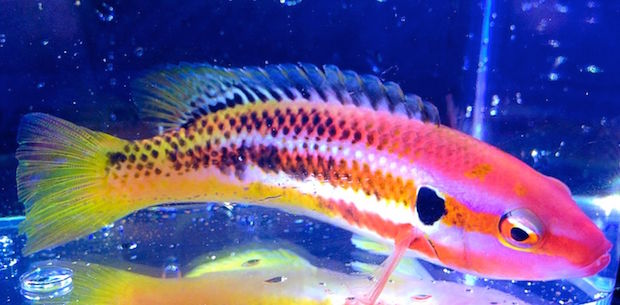This is one very attractive and unusual Izu hogfish which has us quite stumped about its origin. The image below is the first look we got of this particular specimen showing a near perfect blend of the color pattern of a candy hogfish and an Izu hogfish, Bodianus bimaculatus and B. izuensis.

The candy hogfish is a common aquarium fish but the Izu hogfish is actually quite rare outside of the Asian aquarium market. So to see an Izu hogfish with an unusual color pattern really caught our attention as this fish most commonly displays a trio of zig-zag black stripes on a white body and bordered in reddish maroon, fading to deep red on the face.

This particular “hybrid” hogfish was sourced from Java, Indonesia by Russo’s Reef and it was delivered to the Elos AquaStudio in New Jersey where these follow up pictures are from. Now as we mentioned, the Izu hogfish is more common around Asian aquarium markets because the Izu hogfish is primarily found in the northwest pacific Ocean from the Philippines to Japan but it also ranges to Indonesia and Australia.

So if this particular fish really did come from Java, this would represent the extreme end of this species range. The edge of species’ ranges is where they become fewer and further spread out making it more likely that hybridization might occur with another, closely related species, leading to hybrid specimens.

Hybrids of hogfish have not been documented to our knowledge, making this specimen the only such suspected hybrid fish in the genus Bodianus that we have ever encountered. Even once it settled in this unusual Izu hogfish continued to show a perfect blend of colors with the Izu hogfish and candy hog, with a much more pronounced pink coloration in the face and brighter yellow coloration in the tail. This specimen even has the vestiges of the black spot in the tail precisely where we’d expect to see it in the candy hogfish.

Oh but the plot thickens because another specimen of Izu hogfish was shipped alongside the supposed hybrid, pictured above by LiveAquaria, and it also shows an atypical coloration for Bodianus izuensis with much less defined lateral stripes and a muddy coloration for the species in general. While researching for more examples of Indonesian Bodianus izuensis we discovered that the species does trend towards this less defined color pattern at the western end of its range but these two individuals from Java are more extreme in this regard.

The origin of these two hogfish are notable because Java is not far from the geographical hotspot of hybridization in marine fish that has already been identified in the Eastern Indian Ocean. Our final conclusion about this hybrid Izu hogfish is that it represents an actual hybrid population of Bodianus izuensis with B. bimaculatus similar to what we see with the Rusty Flame angelfish hybrids which outnumber their flame angelfish parents in the Northern Philippines, and regions of the south Pacific where black-tailed lemonpeels completely displace pure-blooded Centropyge flavissima.
There is no way to confirm this theory without genetic analysis but whatever the case, this is one sexy and storied hogfish which looks beautiful and different from anything we’ve seen before. Huge thanks to Ryan Grieder for providing a great photo spread of this eye-catching Izu Hogfish chilling at Elos AquaStudio where this little guy is still chillin’ waiting for a nice aquarium to call home.



